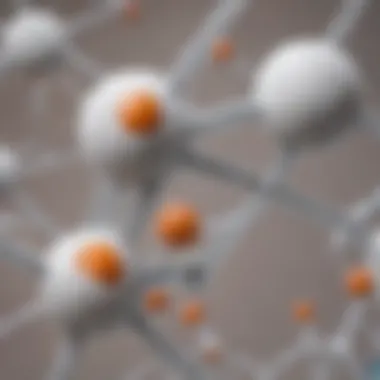Understanding the Versatility of Bicarbonate of Soda


Intro
Bicarbonate of soda, or baking soda, is often found in your kitchen, but its role extends far beyond cooking. Understanding its chemical properties and diverse applications reveals a substance that holds potential across various domains, including health and environmental practices. This exploration aims to dissect not only its foundational elements but also how it shapes everyday life in nuanced ways.
Baking soda's chemical formula is NaHCO₃, illustrating its simple yet effective structure. This compound demonstrates versatile functionality owing to its alkaline nature, which reacts with acids to produce carbon dioxide gas. This reaction is the key driver behind its use in leavening baked goods.
The broad applications of bicarbonate of soda do not stop at baking. Its antacid properties make it valuable in health and wellness, and it plays a significant part in environmental cleanup initiatives. Understanding these varied roles is crucial for effectively utilizing baking soda in different settings. The following sections will explore specific practical applications while allowing for deeper insight into the effective integration of sodium bicarbonate into daily practices.
What is Bicarbonate of Soda?
Bicarbonate of soda, commonly known as baking soda, plays a crucial role across a variety of fields, especially in culinary and health contexts. This compound is more than just an ingredient in baking; it possesses unique properties that allow it to contribute effectively to different applications. Understanding what bicarbonate of soda is can truly enhance its proper usage, enabling individuals to realize its full potential.
Chemical Composition
Bicarbonate of soda's chemical formula is NaHCO₃. This indicates that it is made up of sodium (Na), hydrogen (H), carbon (C), and oxygen (O). Each atom within bicarbonate plays an important role in its behavior.
Sodium serves essential functions in cellular processes. Hydrogen suggests that this compound can act as an acidifier. The carbonate component brings a unique buffering capacity, which is vital in environments requiring pH regulation. Overall, its foundational composition directly connects to its versatile uses.
Bicarbonate of soda undergoes certain chemical reactions when exposed to acidic agents, which release carbon dioxide. This reaction is responsible for the leavening effect in baking, transforming batters into fluffy delights and is one of the key traits attractive to those in the culinary field.
Physical Properties
Bicarbonate of soda primarily appears as a white crystalline powder. It is granular to a certain degree and seems dry to touch. Its solubility in water is moderate; it dissolves readily. When dissolved, it forms a mildly alkaline solution.
This compound has a slightly salty flavor with no noticeable smell. However, it can react vigorously if mixed with strong acids, resulting in fizzing and effervescence. This property is not only exciting in scientific observations but is also practically helpful when considering its application in cleaning tasks. The high thermal stability indicates that it does not break down easily at moderate temperatures, making it suitable for various cooking processes.
Bicarbonate of soda facilitates physiological and chemical functions across diverse fields, showcasing its flexibility and importance.
Understanding the chemical makeup and physical characteristics of bicarbonate of soda enhances its practical applications and benefits. Chefs, health enthusiasts, and eco-conscious individuals alike can harness the University of this compound for improved outcomes in their respective practices.
Historical Context
Understanding the historical context of bicarbonate of soda provides significant insights into its multifaceted role in both culinary and health applications. This exploration sheds light on how it was discovered and used in early civilizations, leading us to today's diverse utilizations. Awareness of its history enhances appreciation for this compound that often resides in our kitchens unnoticed.
Discovery and Early Uses
Bicarbonate of soda, also known commonly as baking soda, traces its origins back thousands of years. Its earlier form, natron, was a naturally occurring mineral found in ancient Egyptian tombs, and it was employed for human hygiene and as a preservative for embalmment. The actual bicarbonate compound began to emerge in the late 18th century, during which prominent chemists recognized its uses. Christopher Sidney, in 1791, is often credited with this discovery when he found out that sodium bicarbonate could produce carbon dioxide gas when mixed with acids.
Historically, bicarbonate played an essential role in making bread rise before the advent of commercial yeast. Professional bakers relied on it to create what we know today as leavening. Baked items produced using bicarbonate resulted in lighter textures and improved flavors. Today, these early applications serve as a primary inspiration for modern baking techniques. The material became pivotal, and usage expanded from bakeries to households.
Additionally, early pharmaceutical uses included antacid formulations, providing relief from numerous digestive ailments. This century-spanning notoriety formed a solid foundation for its integration into both culinary and medicinal contexts. Above all, its safe digestible nature established trust in various communities, quite essential for its growth processing through the ages.
Evolution of Applications
As time moved forward, the applications of bicarbonate of soda evolved significantly due to advancements in science and technology. In the 19th and 20th centuries, further chemical investigations led to understanding how bicarbonate reacts with acids, releasing carbon dioxide gas. This reaction was utilized not only in baking but also laid the groundwork for innovative preservation methods.
Household uses expanded as people discovered bicarbonate's properties beyond baking. Its effective cleaning abilities caught attention in the early 20th century, assisting homemakers to maintain a clean and hygienic environment. It works well in removing stains, grease, and odors - vital within the domestic space.
The growth of applications continues in various sectors today:
- Utilization in oral health products.
- Uses pest control products gaining traction among environmentally conscious consumers.
- Implementation in industries such as fire extinguishing tech, emphasizing versatility.
Thus, monitoring the historical journey of bicarbonate of soda demonstrates the diverse roles it has relentlessly served throughout recorded time. Such knowledge prompts us to respect this humble compound and inspires innovative uses moving into the future, which holds great promise for further exploration.
“Bicarbonate of soda's path through history illustrates how traditional knowledge can evolve into invaluable solutions for modern dilemmas.”
Culinary Applications
Culinary applications of bicarbonate of soda are crucial for both professional chefs and home cooks. It is more than just an ingredient; its multifaceted roles enhance various aspects of cooking and baking. Understanding how bicarbonate of soda functions in culinary practices allows cooks to leverage its potential effectively.
Leavening Agent


As a leavening agent, bicarbonate of soda unleashes its transforming power when combined with acidic ingredients. It produces carbon dioxide gas, which causes dough to rise. This chemical reaction occurs immediately when baking soda encounters an acidic substance, such as vinegar, buttermilk, or yogurt. The result is a light, airy texture in baked goods like muffins, cakes, and pancakes.
The amount of baking soda used is paramount. Too much can lead to undesirable flavors and a bitter taste, while too little may result in dense, heavy pastries. Accurate measurement is key to mastering the balance.
pH Regulation in Cooking
Bicarbonate of soda also plays a vital role in pH regulation within cooking processes. It acts as a food base, adjusting the acidity or alkalinity of various dishes. This capability promotes browning in cooking owing to the Maillard reaction, which is essential for developing flavors, especially in meats and baked items.
Furthermore, it can assist in neutralizing excess acidity in specific recipes. This is particularly beneficial when making sauces or soups that may have gone too tangy. By knowing how to use bicarbonate of soda to manage pH levels, cooks can refine their culinary creations.
Flavor Enhancement
Beyond leavening and pH control, bicarbonate of soda has the potential to enhance flavors subtly. While it is commonly included for chemical reactions, it can also modify taste profiles through careful usage. For instance, a small quantity can help mellow out overly acidic foods, making them more palatable. Efficacious use can distinguish a well-balanced dish from one that fails to have depth.
It is important to use bicarbonate judiciously, as excessive amounts may likewise yield opposite effects, masking other flavors. A delicate hand ensures harmonious flavor development.
An informed approach to bicarbonate of soda in culinary applications can greatly expand the quality and finesse of dishes prepared.
Recognizing these distinct facets of bicarbonate of soda not only enhances individual dishes but also contributes to broader culinary practices and innovations. Adoption of these applications can elevate cooking skills while ensuring delightful dining experiences.
Health Benefits
The significance of bicarbonate of soda extends into various health benefits which warrant attention in this exploration. This compound exhibits properties that can contribute to overall wellness. Understanding these health benefits is crucial, especially for those who seek natural remedies and alternatives to pharmaceuticals. The following areas demonstrate its impactful role in health.
Digestive Aid
Bicarbonate of soda often finds a place as a natural digestive aid. When ingested, it dissolves in the stomach's acidic environment, resulting in neutralization of stomach acid. This can provide relief from occasional heartburn and indigestion. The ability to balance pH levels aids in minor discomfort occasionally experienced after meals.
Many people choose to use bicarbonate of soda as a quick solution for an upset stomach, as it interacts with acids effectively. Additionally, mixing a small amount into water can enhance its effectiveness, offering soothing relief. However, dosage is key, as excessive consumption may lead to side effects, including gas or bloating. Consult with a healthcare number if doubts arise regarding its use.
Alkalinity Restoration
A body with balanced pH is essential for optimal health. An overly acidic environment may lead to various ailments. Intake of bicarbonate of soda can help restore the body's alkaline levels. This is significant since it aids in reducing metabolic acidosis, a condition where excess acids accumulate in the body.
Consuming bicarbonate may help athletes overcome fatigue during and after vigorous activities. Ensuring mobile and energized body, it assists in recovery and performance efficiently. Also, it is worth noting that extremes—either highly acidic or overly alkaline environments—can detrimentally affect body functions.
Potential in Oral Health
Bicarbonate of soda can also prove beneficial within oral health regimens. Many toothpaste brands utilize this compound due to its abrasive quality that assists in removing plaque and surfaces stains from teeth. It contributes to a whiter smile since it aids in Tennessee against discoloration. Furthermore, its antibacterial properties contribute to healthier gums and breath.
Caution must be exercised, however, where excessive use can cause enamel erosion. In moderation, it fits reasonably well within a proper dental hygiene routine and has emerged as a sought-after natural option. Regular use can provide fresher breathe, and equal dental benefits if consumers explore suitable alternatives.
The holistic potential of bicarbonate of soda spans multiple health contexts from aiding digestion to oral care, promising a natural AND versatile approach to well-being.
In summary, bicarbonate of soda demonstrates various health benefits essential for improving day-to-day life. Understanding these elements empowers individuals, thereby enhancing wellness in a sustainable manner. Utilization of this compound may integrate more positively into conscious health practices.
Applications Beyond the Kitchen
Bicarbonate of soda, frequently recognized as baking soda, has extensive uses that extend far beyond the realms of food preparation. Its diverse properties make it valuable in various non-culinary arenas, impacting household cleaning, deodorization, and even fire safety. Understanding these applications sharpens our appreciation for the compound and showcases its versatility.
Household Cleaning
Bicarbonate of soda is notable for its remarkable cleaning capabilities. It acts as a mild abrasive, perfect for scrubbing surfaces without leaving scratches. Common items where it can be applied include sinks, countertops, and bathroom surfaces. To utilize this effectively, one can mix baking soda with water to create a paste that clings to surfaces, lifting stains without the harshness of chemicals.
Some specific benefits of using bicarbonate of soda for cleaning include:
- Eco-friendliness: Unlike many commercial cleaning products, it is non-toxic and safe for the environment.
- Affordability: It is generally inexpensive, providing a cost-effective solution for cleaning needs.
- Deodorizing Properties: Its ability to neutralize odors rather than just mask them enhances its cleaning role.
Applications in cleaning extend to:
- Kitchen: Removing baked-on grease from cookware.
- Laundry: Enhancing detergents by softening water.
Bicarbonate of soda's multitasking role in cleaning supports healthier homes and aids in avoiding processed chemical cleaners.


Deodorization
Bicarbonate of soda is extremely effective for deodorization. Its effective neutralizing nature helps eliminate unpleasant odors in various situations. For instance, placing an open box of baking soda in the refrigerator significantly reduces lingering smells from food.
Key Areas for Deodorization:
- Refrigerators and Freezers: It absorbs odors effectively, making it an ideal choice.
- Carpeting and Fabrics: Sprinkling on carpets, allowing it to sit for a while, and then vacuuming can lift dirt and odors.
Using bicarbonate of soda as a deodorizer provides these advantages:
- Non-toxic: Safe for homes with pets and children.
- Affordable and Accessible: Readily available at grocery stores.
Consistent use in various household applications demonstrates why bicarbonate of soda has earned its place in home maintenance routines.
Fire Extinguishing Properties
Interestingly, bicarbonate of soda holds potential as a fire suppressant. When heated to high temperatures, it decomposes to release carbon dioxide, smothering flames and hindering combustion. It is particularly useful for addressing grease fires in kitchens despite not replacing conventional fire extinguishers.
Benefits in Fire Safety
- Quick Accessibility: Many kitchens already have baking soda readily available, making it an immediate response option.
- Reduction of Flames: The carbon dioxide prevents re-ignition of fire sources.
To utilize it against small grease fires, apply baking soda directly onto flames. It is critical to emphasize that this method is suitable only for specific situations like grease fires and shouldn’t substitute the use of dedicated fire extinguishers. An understanding of these practical applications is essential, merging household safety and chemical understanding.
Utilizing bicarbonate of soda effectively can enhance both home cleanliness and safety, needfully placing this compound at the forefront of household solutions.
Environmental Considerations
The discussion surrounding bicarbonate of soda extends beyond kitchen and health applications. Its environmental considerations are worth noting. This compound can serve various roles that support sustainability, lessening carbon footprints and promoting effective practices in agriculture and home environments.
Sustainable Uses
Bicarbonate of soda displays versatility in sustainable approaches. For instance, it has a role in natural cleaning solutions, replacing harsher chemicals that harm ecosystems. Households can utilize this compound to clean surfaces, while reducing hazardous waste. Furthermore, industries are adopting baking soda in their processes to lessen pollution.
- Cleaning: Non-toxic theant for surfaces in kitchens, bathrooms, and more.
- Pest Control: An alternative to chemical pesticides. Ants and roaches can be deterred with mixtures of soda and sugar, promoting safe pest management.
- Plant Care: The compound can be used to adjust soil pH, providing healthy conditions for crops.
Each use not only exemplifies practical application but also aligns with a more sustainable mode of living.
Impact on Soil and Water Regulation
Bicarbonate of soda can positively influence soil and water quality. When managing soil health, it acts as a pH regulator. This aspect is critical for agriculture, especially for growing various crops, as optimal pH levels support plant nutrition and yields. Additionally, controlling alkaline reactions can improve nutrient uptake.
In water treatment systems, bicarbonate works to manage acidity.
- Buffering agent: It helps maintain stable pH levels, crucial in aquaculture and irrigation.
- Remediation: Helps neutralize contaminated waters, contributing to healthier ecosystems.
Best Practices for Use
Understanding the best practices for the use of bicarbonate of soda is essential for both effective application and achieving desirable outcomes. Given its versatility, improper use can lead to suboptimal results, particularly in cooking. For those who cherish baking, a precise dosage is not just crucial, it's key to achieving the right texture and flavor in baked goods.
Recommended Dosage in Cooking
When using bicarbonate of soda in cooking, the recommended dosage often depends on the specific recipe and the intended effect. Generally, a range of 1/4 to 1 teaspoon is common for most recipes requiring this compound. Here are some considerations:
- In Baking: Embedding 1/2 teaspoon of bicarbonate of soda per cup of flour typically achieves adequate leavening.
- Reacting with Acid: It’s vital to couple bicarbonate with an acidic ingredient like yogurt, lemon juice, or vinegar, stressing that a proper balance promotes a chemical reaction producing carbon dioxide that contributes to the rise of the batter.
- Adjusting to Taste: If used in savory dishes, adjustments might be necessary based on the other flavor elements present. Too much bicarbonate can lend an undesired alkaline or chemical flavor, which can detract from the food's natural taste.
Using the right dosage might also prevent excessive browning or change in texture. Understanding the ratio between bicarbonate of soda and acids in recipes is pivotal to achieving culinary excellence.
Safety Precautions
While bicarbonate of soda is generally recognized as safe, like all substances, it is critical to observe certain safety precautions:


- Storage Measures: Store bicarbonate of soda in a cool, dry place and tightly sealed to prevent moisture absorption. When mixed with liquids, its properties change quickly.
- Consumption Limits: This substance should not be overconsumed, as it can lead to digestive issues if indulged beyond recommended amounts.
- Allergies and Sensitivities: Some individuals could be sensitive to it, so mindful consumption and awareness are merited.
Ultimately, approaching the use of bicarbonate of soda with knowledge can optimize your experience, not just in cooking but in various applications around the home. A few simple practices rooted in understanding can yield satisfying results. While one explores this compound's versatility, always stay informed and attentive to its properties and effects.
“Bicarbonate of soda can be a cook's best friend, but it can also be tricky without best practices.”
Bicarbonate of Soda vs.
Other Compounds
Understanding bicarbonate of soda in relation to other compounds is significant for multiple reasons. This comparison highlights its unique properties, diverse applications, and its value across different fields. Bicarbonate of soda, often used interchangeably with baking soda, serves varied functions beyond being a mere leavening agent.
When compared to other compounds, it is essential to recognize its distinct chemical structure and versatility. This understanding aids in practical applications and promotes informed choices in context like cooking and health.
Comparison with Baking Powder
Baking powder and bicarbonate of soda are frequently categorized together in cooking, yet they are different in several key aspects. Baking powder contains bicarbonate of soda, but it also includes an acid – often cream of tartar – and a moisture-absorbing component, like starch.
- Bicarbonate of soda requires an acidic ingredient to activate its leavening power, such as vinegar, yogurt, or lemon juice.
- Baking powder, being a complete leavening system, can act independently when liquid and heat are present. This makes it less dependent on additional acid when baking.
- Chefs may prefer one over the other based on the specific texture or taste they want to achieve in baked goods. The subtle variations in outcomes they generate can be critical for more advanced culinary creations.
Differences from Baking Soda and Potash
Here, the difference between baking soda, potassium carbonate (often termed potash), and bicarbonate of soda is highlighted clearly.
Baking soda, synonymous with bicarbonate of soda, denotes a single compound, whereas potash encompasses a range of potassium carbonate forms. Understanding these distinctions is useful for consumers and cooks alike.
- Baking Soda (Sodium Bicarbonate): Primarily used for cooking and in small-scale health applications. It's essential for providing that quick, light texture in baked items.
- Potash: Historically used in glass manufacture and as fertilizer, but it's not suitable for baking in the same sense as bicarbonate of soda. ; For educated consumers, knowing these elements can shape their shopping, cooking, and health decisions significantly. With turmoil in the marketplace, recognizing that not all white powders labeled as 'baking' serve equal functions is indeed crucial.
Understanding the subtle differences between these compounds aids chefs and home cooks in honing their skills. Knowing when to use which can be impact full on end results and even nutritional uptake in some cases.
Grasp these comparisons and better realize the fascinating role bicarbonate of soda plays not only in your kitchen but also in broader applications throughout various sectors.
Controversies and Misconceptions
Controversies and misconceptions surrounding bicarbonate of soda are key to understanding its true value. Awareness of these topics prevents misinformation and enables individuals to utilize this compound correctly. Overall, rhsproken and underpin efficacy of bicarbonate in various aspects are clarified significantly through comprehensive enlightenment.
Myths Regarding Health Claims
Many health claims associated with bicarbonate of soda lack scientific support. A misconception persists that it can cure serious diseases, including cancer and diabetes. Research shows mild health benefits, such as assisting in digestion and reducing acid levels. However, pacing expectations to realistic scenarios is crucial. Misrepresenting its capabilities can lead to deleterious behaviors, causing misjudged reliance on bicarbonate as a remedy. Here's an overview of popular myths about its health effects:
- Cancer Treatment: No credible evidence exists showing bicarbonate of soda treats malignant tumors effectively.
- Soda Detox Claims: Cryptids treat bile and toxic sludge in the body incorrectly associate bicarbonate.
- Cure for Diabetes: Misinterpretatioins entail anecdotal results fail to prove viable health support.
While bicarbonate can contribute positively in health contexts, hyping its abzilities veers away from honest mguments.
Misunderstandings in Culinary Use
Misunderstandings regarding bicarbonate of soda’s role in cooking often stem from its complex properties and behavior. Many believe it to act as a direct substitute in all situations. This assumption can lead to problems in baking.
Here are notable misunderstandings to consider:
- Not a Replacement for Baking Powder: Baking soda and baking powder are distinct substances with specific contexts of use. Confusing the two affects the final results in recipes that depend on correct leavening.
- Quantity Matters: Using too much can alter flavor and affect the texture, resulting in unpleasant tastes. Precise measurements maintain balance in results.
- Acidity Requirement: Many users fail to recognize bicarbonate needs acidic components in dishes. The reascction with acids enables desired chemical processes to occur.
Clarifying these aspects allows for optimal use. A deeper understanding hhelps for both experimenters in cooking and culinary enthusiasts.
Establishing facts clears haziness aroundարը with rational discussions and better results.
Future Research Directions
Future research into bicarbonate of soda reveals the trajectory of this versatile compound beyond traditional applications. Refreshing our perspective on bicarbonate of soda (or baking soda) can lead to new understanding and innovations. Key aspects to consider will be its environmental implications, potential healthcare innovations, and applications in various fields. Supporting exploration in these areas could significantly improve utility while addressing contemporary health and ecological issues.
Innovative Uses Under Investigation
Current studies focus on the multifaceted applications of bicarbonate of soda, aiming to uncover innovative uses. For instance, investments in agricultural research have shown promise in using bicarbonate for crop resilience, particularly in mitigating stress from environmental flavors. Scientists are also exploring its role in carbon capture technologies, where bicarbonate may assist in the reduction of carbon dioxide emissions.
Another area of interest is its potential as a biodegradable alternative in industrial applications. Research assesses its efficacy in reducing the environmental footprint of cleaners and disinfectants, especially in microbial control. With increased scrutiny on harmful substances, bicarbonate’s intrinsic properties could provide a green solution.
- Probable Investigative Areas:
- Utilization in carbon dioxide sequestration.
- Application in sustainable agriculture.
- Sustainable cleaning products development.







